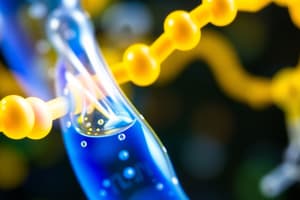Podcast
Questions and Answers
What is the primary role of enzymes in chemical reactions?
What is the primary role of enzymes in chemical reactions?
- Increasing the activation energy required
- Lowering the temperature of the reaction
- Being consumed by the reaction
- Lowering the activation energy required (correct)
Which of the following statements best describes enzyme denaturation?
Which of the following statements best describes enzyme denaturation?
- Enzymes become more effective at higher temperatures
- Enzymes lose their shape and cannot perform their function (correct)
- Enzymes require lower pH for optimal activity
- Enzymes retain their shape and function
At what temperature does enzyme activity typically peak?
At what temperature does enzyme activity typically peak?
- At low temperatures close to 0°C
- At consistently high temperatures above 50°C
- At varying temperatures depending on the enzyme (correct)
- At room temperature regardless of the enzyme
Which enzyme works best at an acidic pH?
Which enzyme works best at an acidic pH?
What happens to enzyme activity as the pH deviates from its optimal level?
What happens to enzyme activity as the pH deviates from its optimal level?
What is formed when maltose undergoes hydrolysis?
What is formed when maltose undergoes hydrolysis?
Which of the following best describes the behavior of enzymes at low temperatures?
Which of the following best describes the behavior of enzymes at low temperatures?
Which product is formed when lipids are broken down?
Which product is formed when lipids are broken down?
What is the role of the micropyle in seed germination?
What is the role of the micropyle in seed germination?
Which enzyme is responsible for breaking down starch into maltose during seed germination?
Which enzyme is responsible for breaking down starch into maltose during seed germination?
What happens to maltose after it is produced during seed germination?
What happens to maltose after it is produced during seed germination?
What is the final product of glucose metabolism in the embryo during germination?
What is the final product of glucose metabolism in the embryo during germination?
What color change is observed when iodine solution is mixed with starch during an investigation?
What color change is observed when iodine solution is mixed with starch during an investigation?
Which of the following statements about protease in seed germination is correct?
Which of the following statements about protease in seed germination is correct?
How do glucose and amino acids move from the cotyledon to the embryo?
How do glucose and amino acids move from the cotyledon to the embryo?
What is the initial step in the process of seed germination?
What is the initial step in the process of seed germination?
Flashcards are hidden until you start studying
Study Notes
Function of Enzymes
- Enzymes speed up chemical reactions by acting as biological catalysts.
- They can break down large molecules into smaller ones, known as catabolism.
- Examples: Starch breakdown into maltose, Maltose breakdown into glucose, Protein breakdown into amino acids, and Lipids breakdown into glycerol and fatty acids.
- Enzymes can also build up large molecules from smaller ones, also known as anabolism.
- Examples: Joining glucose molecules to form Maltose, multiple glucose molecules joining to make Glycogen (in animal cells), and multiple glucose molecules joining to form starch (in plant cells).
Role of Enzymes in Chemical Reactions
- Enzymes are reusable and can catalyze multiple reactions.
- Enzymes lower the activation energy of a reaction, making it easier for the reaction to occur.
Effect of Temperature on Enzyme Activity
- Enzymes have an optimal temperature for maximum activity.
- Below optimal temperature, enzyme activity increases as temperature increases due to an increase in kinetic energy.
- Above optimal temperature, enzyme activity decreases and eventually stops due to enzyme denaturation.
Denaturation
- Denaturation is the loss of an enzyme's shape and function.
- Changes in the shape of the active site prevent substrates from binding.
Effect of pH on Enzyme Activity
- Each enzyme has an optimal pH at which it functions best.
- The pH affects the shape of the active site, influencing substrate binding and enzyme activity.
Examples of Enzyme Activity at Different pH
- Pepsin, found in the stomach, works best at acidic pH (pH 1.5).
- Amylase, present in saliva, works best at neutral pH (pH 7).
- Lipase, located in the small intestine, works best at alkaline pH (pH 8).
The Role of Enzymes in Seed Germination
- Seed germination involves the development of a seed into a new plant.
- Dry broad beans contain stored food reserves (starch, protein, lipids, and enzymes) in the cotyledons.
Steps of Seed Germination
- Absorption of water: This activates enzymes and initiates germination.
- Amylase converts starch to maltose: This hydrolysis reaction requires water and releases energy for the embryo.
- Maltose is converted to glucose: This provides energy for embryo growth.
- Glucose diffuses to cells: This fuels respiration and energy production.
- Phloem transports glucose and amino acids: This distributes nutrients from the cotyledon to the growing embryo.
- Protease breaks down protein to amino acids: This provides building blocks for embryo growth.
Investigations
- Iodine solution is used to detect starch due to its color change from yellow to blue-black in the presence of starch.
- The effect of amylase on starch can be observed by comparing the color changes in test tubes with and without amylase.
- Amylase breaks down starch, resulting in a gradual color transition from blue-black to light blue and finally yellow-brown.
- Test tubes without amylase will remain blue-black due to the presence of intact starch.
Studying That Suits You
Use AI to generate personalized quizzes and flashcards to suit your learning preferences.




